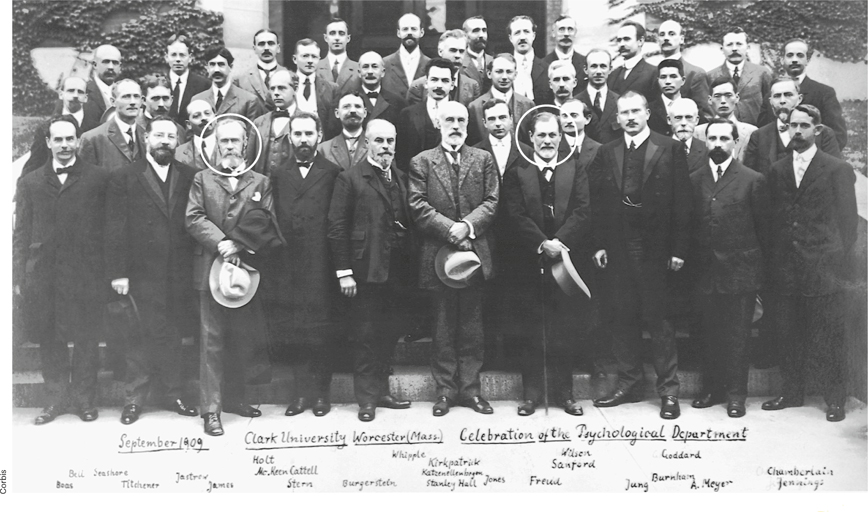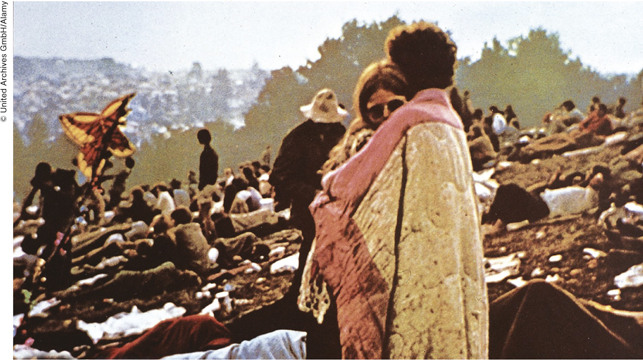The Path to Freud and Psychoanalytic Theory

In this photograph, Sigmund Freud (1856–1939) sits by the couch reserved for his psychoanalytic patients, where they would be encouraged to recall past experiences and bring unconscious thoughts into awareness.
Rue des Archives/The Granger Collection, NYC All rights reserved.
In the mid-19th century, the French physician Jean- Martin Charcot (1825–1893) became interested in studying patients who had developed an unusual condition then known as hysteria, which is a temporary loss of cognitive or motor functions, usually as a result of emotionally upsetting experiences. Some of these patients were blind, some were paralyzed, and others were unable to remember their pasts—and yet, there was no obvious physical cause for any of these symptoms. Charcot discovered that when he put these patients into a trancelike state by using hypnosis, their symptoms disappeared—the blind could see, the paralyzed could walk, and the amnesiac could remember! But after coming out of their trances, their symptoms reappeared. In short, patients in a normal waking state and a trancelike hypnotic state behaved like two different people.
hysteria
A temporary loss of cognitive or motor functions, usually as a result of emotionally upsetting experiences.
How was Freud influenced by work with hysteric patients?

This famous psychology conference, held in 1909 at Clark University, brought together many notable figures, such as William James and Sigmund Freud. Both men are circled, with James on the left.
Corbis
Charcot’s striking observations made a big impression on a young physician from Vienna, Austria, named Sigmund Freud (1856–1939). Freud theorized that hysteria was caused by painful childhood experiences that the patient could not remember. Freud suggested that these memories resided in the unconscious, which is the part of the mind that operates outside of awareness but that influences thoughts, feelings, and actions. This idea led Freud to develop psychoanalytic theory, an approach that emphasizes the importance of unconscious mental processes in shaping feelings, thoughts, and behaviors. Psychoanalytic theory formed the basis for a therapy that Freud called psychoanalysis, which focuses on bringing unconscious material into conscious awareness to better understand psychological disorders. Freud’s theory suggested that the key to curing psychological problems was to help people remember the early experiences that were causing those problems. During psychoanalysis, patients were led to recall past experiences (“When I was a toddler, I was frightened by a masked man on a black horse”) and to articulate their dreams and fantasies (“Sometimes I close my eyes and imagine not having to pay for this session”). Making unconscious material conscious was the key to the psychoanalytic cure.
unconscious
The part of the mind that operates outside of conscious awareness but influences conscious thoughts, feelings, and actions.
psychoanalytic theory
An approach that emphasizes the importance of unconscious mental processes in shaping feelings, thoughts, and behavior.
psychoanalysis
A therapeutic approach that focuses on bringing unconscious material into conscious awareness to better understand psychological disorders.
By the early 1900s, Freud’s ideas had attracted a large number of followers in Europe, including soon-to-be-famous psychologists such as Carl Gustav Jung (1875–1961) and Alfred Adler (1870–1937). But his ideas were quite controversial in America because they suggested that understanding mental life required a thorough exploration of a person’s early sexual experiences and unconscious sexual desires—topics that in those days were considered far too racy for discussion. In addition, Freud and most of his followers were physicians who neither conducted psychological experiments in the laboratory nor held positions at universities, so their ideas developed in isolation from the more academic and research-based approaches of people like William James.
Influence of Psychoanalysis and the Humanistic Response
Why are Freud’s ideas less influential today?
Most historians consider Freud to be one of the most influential thinkers of the 20th century, and the psychoanalytic movement influenced everything from literature and history to politics and art. Within psychology, psychoanalysis had its greatest impact on clinical practice, but that influence has been considerably diminished over the past 40 years. This is partly because Freud’s ideas were difficult to test, and a theory that can’t be tested is of limited interest to scientists. But it was also because Freud’s vision of human nature was such a dark one, emphasizing limitations and problems rather than possibilities and potentials. He saw people as hostages to their forgotten childhood experiences and primitive sexual impulses, and the inherent pessimism of his perspective frustrated those psychologists who had a more optimistic view of human nature.

Humanistic psychology offered a positive view of human nature that matched the zeitgeist of the 1960s.
© United Archives GmbH/Alamy
That’s why in the second half of the 20th century, psychologists such as Abraham Maslow (1908–1970) and Carl Rogers (1902–1987) pioneered a new movement called humanistic psychology, an approach to understanding human nature that emphasizes the positive potential of human beings. Humanistic psychologists focused on the highest aspirations that people had for themselves. Rather than viewing people as prisoners of events in their remote pasts, humanistic psychologists viewed people as free agents who have an inherent need to develop, grow, and attain their full potential. This movement reached its peak in the 1960s when a generation of “flower children” found it easy to see psychological life as a kind of blossoming of the spirit. Humanistic therapists sought to help people realize their full potential; in fact, such therapists called them clients rather than patients. In this relationship, the therapist and the client (unlike the psychoanalyst and the patient) were on equal footing. The development of the humanistic perspective was one more reason why Freud’s ideas eventually became less influential.
humanistic psychology
An approach to understanding human nature that emphasizes the positive potential of human beings.
SUMMARY QUIZ [1.2]
Question
1.8
| 1. |
To understand human behavior, Jean-Martin Charcot studied people |
- who appeared to be completely healthy.
- with psychological disorders.
- with damage in particular areas of the brain.
- who had suffered permanent loss of cognitive and motor function.
b.
Question
1.9
| 2. |
Building on the work of Charcot and others, Sigmund Freud developed |
- psychoanalytic theory.
- the theory of hysteria.
- humanistic psychology.
- physiological psychology.
a.
Question
1.10
| 3. |
The psychological theory that emphasizes the positive potential of human beings is known as |
- structuralism.
- psychoanalytic theory.
- humanistic psychology.
- functionalism.
c.


